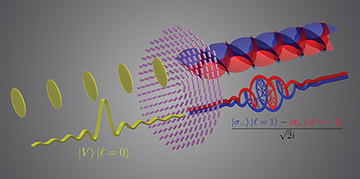 A single-photon, vertically polarized and with zero OAM (yellow wavepacket and flat phase front, respectively), passes through the metasurface (purple), and exits as a single-particle entangled state, depicted as a superposition of the red and blue electric-field amplitudes with the corresponding vortex phase fronts opposite to one another. [Enlarge figure]
A single-photon, vertically polarized and with zero OAM (yellow wavepacket and flat phase front, respectively), passes through the metasurface (purple), and exits as a single-particle entangled state, depicted as a superposition of the red and blue electric-field amplitudes with the corresponding vortex phase fronts opposite to one another. [Enlarge figure]
Metamaterials are artificial structures assembled from multiple elements smaller in scale than the wavelength of the external stimuli. They can endow a medium with unique electromagnetic response and functionalities. Metasurfaces—metamaterials of reduced dimensionality—are phased arrays composed of resonant optical nanoantennas, facilitating substantial control of local light scattering properties.
Controlling the electromagnetic response of metasurfaces can be achieved by a geometric-phase mechanism (Pancharatnam-Berry phase), enabling spin-controlled manipulation for classical light.1,2 Metasurfaces have also been suggested as a new platform for quantum optics and quantum information. In work this year, we experimentally established quantum entanglement and its manipulation using a metasurface platform.3
Quantum information provides a route to solve problems in reduced time and complexity, by exploiting fundamental concepts in quantum physics such as superposition and entanglement.4 The easy manipulation of single photons, often propagating with low decoherence, makes the construction of optical quantum processing units very appealing.
In our recent paper,3 we achieved the first experiment demonstrating entanglement generation by metasurfaces and manipulation of these entangled photon states. The platform for these accomplishments was a lossless dielectric metasurface, the high efficiency of which enables manipulation of single photons. Our scheme relied on a geometric-phase metasurface (GPM) that generates entanglement between the spin and the orbital angular momentum (OAM) of photons.
To entangle the photon spin to its OAM, we designed a GPM embedded with a spin-dependent helical phase. Such a metasurface performs a unitary transformation that adds or subtracts one quanta of OAM, depending on the sign of the photon spin. In our case, the spatial wavefunction of the photon is paraxial; therefore the spin and the OAM are independent and have Hilbert spaces of different dimensions.
We used spontaneous parametric down-conversion to create single photons, each with zero total angular momentum. This state of light passed through the GPM, where the interaction resulted in a single photon in an entangled state. Using quantum state tomography, we experimentally recovered the density matrices of the four Bell states with fidelity of more than 90%.
At a second stage, we used photon pairs, and demonstrated nonlocal correlations between the spin of one photon and the OAM of another photon—correlations that cannot be reproduced with classical light. Finally, we used the metasurface setting to demonstrate a quantum SWAP gate.
Our results suggest that metamaterials are suitable for generating and manipulating entangled photon states, and thereby introduce the area of quantum-optics metamaterials.
Researchers
Elhanan Maguid, Tomer Stav, Arkady Faerman, Dikla Oren-Caspi, Vladimir Kleiner, Mordechai Segev and Erez Hasman, Technion, Haifa, Israel
References
1. Z. Bomzon et al. Opt. Lett. 27, 285 (2002).
2. E. Maguid et al. Science 352, 1202 (2016)
3. T. Stav et al. Science 361, 1101 (2018)
4. B.G. Englert et al. Phys. Rev. A 63, 032303 (2001).
